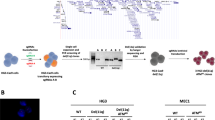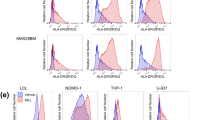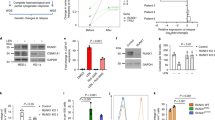Abstract
Several human disorders mutated in core components of the major DNA double-strand break (DSB) repair pathway, non-homologous end joining (NHEJ), have been described. Cell lines from these patients are characterized by sensitivity to DSB-inducing agents. DNA ligase IV syndrome (LIG4) patients specifically, for unknown reasons, respond particularly badly following treatment for malignancy or BMT. We report the first systematic evaluation of the response of LIG4 syndrome to compounds routinely employed for BMT conditioning. We found human pre-B lymphocytes, a key target population for BMT conditioning, when deficient for DNA ligase IV, unexpectedly exhibit significant sensitivity to CsA the principal prophylaxis for GVHD. Furthermore, we found that CsA treatment alone or in combination with BU and fludarabine resulted in increased levels of DSBs specifically in LIG4 syndrome cells compared to wild-type or Artemis-deficient cells. Our study shows that CsA can induce DSBs and that LIG4 syndrome patient's fail to adequately repair this damage. These DSBs likely arise as a consequence of DNA replication in the presence of CsA. This work has implications for BMT and GVHD management in general and specifically for LIG4 syndrome.
This is a preview of subscription content, access via your institution
Access options
Subscribe to this journal
Receive 12 print issues and online access
$259.00 per year
only $21.58 per issue
Buy this article
- Purchase on Springer Link
- Instant access to full article PDF
Prices may be subject to local taxes which are calculated during checkout




Similar content being viewed by others
References
Aschan J . Allogeneic haematopoietic stem cell transplantation: current status and future outlook. Br Med Bull 2006; 77–78: 23–36.
Gennery A, Slatter M, Bhattacharya A, Jeggo P, Abinun M, Flood T et al. Bone marrow transplantation for Nijmegan breakage syndrome. J Pediatr Hematol Oncol 2005; 27: 239.
Resnick IB, Shapira MY, Slavin S . Nonmyeloablative stem cell transplantation and cell therapy for malignant and non-malignant diseases. Transpl Immunol 2005; 14: 207–219.
O'Driscoll M, Gennery AR, Seidel J, Concannon P, Jeggo PA . An overview of three disorders associated with genetic instability: LIG4 syndrome, RS-SCID and ATR-Seckel syndrome. DNA Repair 2004; 3: 1227–1235.
Buck D, Malivert L, de Chasseval R, Barraud A, Fondaneche M-C, Sanal O et al. Cernunnos, a novel nonhomologous end-joining factor, is mutated in human immunodeficiency with microcephaly. Cell 2006; 124: 287–299.
O'Driscoll M, Cerosaletti KM, Girard P-M, Dai Y, Stumm M, Kysela B et al. DNA ligase IV mutations identified in patients exhibiting development delay and immunodeficiency. Mol Cell 2001; 8: 1175–1185.
Moshous D, Callebaut I, de Chasseval R, Corneo B, Cavazzana-Calvo M, Le Deist F et al. Artemis, a novel DNA double-strand break repair/V(D)J recombination protein, is mutated in human severe combined immune deficiency. Cell 2001; 105: 177–186.
Ahnesorg P, Smith P, Jackson SP . XLF interacts with the XRCC4–DNA ligase IV complex to promote DNA nonhomologous end-joining. Cell 2006; 124: 301–313.
O'Marcaigh A, DeSantes K, Hu D, Pabst H, Horn B, Li L et al. Bone marrow transplantation for T-B- severe combined immunodeficiency disease in Athabascan-speaking native Americans. Bone Marrow Transplant 2001; 27: 703–709.
Enders A, Fisch P, Schwarz K, Duffner U, Pannicke U, Nikolopoulos E et al. A severe form of human combined immunodeficiency due to mutations in DNA ligase IV. J Immunol 2006; 176: 5060–5068.
van der Burg M, van Veelen LR, Verkaik NS, Wiegant WW, Hartwig NG, Barendregt BH et al. A new type of radiosensitive T-B-NK+ severe combined immunodeficiency caused by a LIG4 mutation. J Clin Invest 2006; 116: 137–145.
Gruhn B, Seidel J, Zintl F, Varon R, Tonnies H, Neitzel H et al. Successful bone marrow transplantation in a patient with DNA ligase IV deficiency and bone marrow failure. Orphanet J Rare Dis 2007; 2: 5.
Kobayashi N, Agematsu K, Sugita K, Sako M, Nonoyama S, Yachie A et al. Novel Artemis gene mutations of radiosensitive severe combined immunodeficiency in Japanese families. Hum Genet 2003; 112: 348–352.
Buckley RH . Molecular defects in human severe combined immunodeficiency and approaches to immune reconstitution. Ann Rev Immunol 2004; 22: 625–655.
Deeg HJ, Leisenring W, Storb R, Nims J, Flowers MED, Witherspoon RP et al. Long-term outcome after marrow transplantation for severe aplastic anemia. Blood 1998; 91: 3637–3645.
Duncan N, Craddock C . Optimizing the use of cyclosporin in allogeneic stem cell transplantation. Bone Marrow Transplant 2006; 38: 169–174.
Reynolds NJ, Al-Daraji WI . Calcineurin inhibitors and sirolimus: mechanisms of action and applications in dermatology. Clin Exp Dermatol 2002; 27: 555–561.
Grawunder U, Zimmer D, Fugmann S, Schwarz K, Lieber MR . DNA ligase IV is essential for V(D)J recombination and DNA double-strand break repair in human precursor lymphocytes. Mol Cell 1998; 2: 477–484.
Riballo E, Kuhne M, Rief N, Doherty AJ, Smith GC, Recio MJ et al. A pathway of double strand break rejoining dependent upon ATM, Artemis and proteins locating to g-H2AX foci. Mol Cell 2004; 16: 715–724.
Rogakou EP, Pilch DR, Orr AH, Ivanova VS, Bonner WM . DNA double-stranded breaks induce histone H2AX phosphorylation on serine 139. J Biol Chem 1998; 273: 5858–5868.
Rogakou EP, Boon C, Redon C, Bonner WM . Megabase chromatin domains involved in DNA double-strand breaks in vivo. J Cell Biol 1999; 146: 905–916.
Fernandez-Capetillo O, Lee A, Nussenzweig M, Nussenzweig A . H2AX: the histone guardian of the genome. DNA Repair 2004; 3: 959–967.
Fernandez-Capetillo O, Chen HT, Celeste A, Ward I, Romanienko PJ, Morales JC et al. DNA damage-induced G2-M checkpoint activation by histone H2AX and 53BP1. Nat Cell Biol 2002; 4: 993–997.
Lindahl T . Instability and decay of the primary structure of DNA. Nature 1993; 362: 709–714.
Caldecott KW . XRCC1 and DNA strand break repair. DNA Repair 2003; 2: 955–969.
Caldecott KW . Mammalian single-strand break repair: mechanisms and links with chromatin. DNA Repair 2007; 6: 443–453.
Caldecott KW . Mammalian DNA single-strand break repair: an X-ra(y)ted affair. Bioessays 2001; 23: 447–455.
Ahlers C, Kreideweiss S, Nordheim A, Ruhlmann A . Cyclosporin A inhibits Ca2+-mediated upregulation of the DNA repair enzyme DNA polymerase beta in human peripheral blood mononuclear cells. Eur J Biochem 1999; 264: 952–959.
Lobrich M, Jeggo PA . Harmonising the response to DSBs: a new string in the ATM bow. DNA Repair 2005; 4: 749–759.
Takata M, Sasaki MS, Sonoda E, Morrison C, Hashimoto M, Utsumi H et al. Homologous recombination and non-homologous end-joining pathways of DNA double-strand break repair have overlapping roles in the maintenance of chromosomal integrity in vertebrate cells. EMBO J 1998; 17: 5497–5508.
Ruutu T, Niederwieser D, Gratwohl A, Apperley J . A survey of the prophylaxis and treatment of acute GVHD in Europe: a report of the European Group for Blood and Marrow Transplantation (EBMT). Bone Marrow Transplant 1997; 19: 759–764.
Deeg HJ, Socie G . Malignancies after hematopoietic stem cell transplantation: many questions, some answers. Blood 1998; 91: 1833–1844.
Buell JF, Gross TG, Woodle ES . Malignancy after transplantation. Transplantation 2005; 80 (2(S)): 254–264.
Tremblay F, Fernandes M, Habbab F, de Edwardes M, Loertscher R, Meterissian S . Malignancy after renal transplantation: incidence and role of type of immunosuppression. Ann Surg Oncol 2002; 9: 785–788.
Herman M, Weinstein T, Korzets A, Chagnac A, Ori Y, Zevin D et al. Effect of cyclosporin A on DNA repair and cancer incidence in kidney transplant recipients. J Lab Clin Med 2001; 137: 14–20.
Herman M, Ori Y, Chagnac A, Weinstein T, Korzets A, Zevin D et al. DNA repair in mononuclear cells: role of serine/threonine phosphatases. J Lab Clin Med 2002; 140: 255–262.
Yarosh DB, Pena AV, Nay SL, Canning MT, Brown DA . Calcineurin inhibitors decrease DNA repair and apoptosis in human keratinocytes following ultraviolet B irradiation. J Investig Dermatol 2005; 125: 1020–1025.
O'Donovan P, Perrett CM, Zhang X, Montaner B, Xu Y-Z, Harwood CA et al. Azathioprine and UVA light generate mutagenic oxidative DNA damage. Science 2005; 309: 1871–1874.
Karran P . Thiopurines, DNA damage, DNA repair and therapy-related cancer. Br Med Bull 2006; 79-80: 153–170.
Franco S, Gostissa M, Zha S, Lombard DB, Murphy MM, Zarrin AA et al. H2AX prevents DNA breaks from progressing to chromosome breaks and translocations. Mol Cell 2006; 21: 201–214.
Franco S, Alt FW, Manis JP . Pathways that suppress programmed DNA breaks from progressing to chromosomal breaks and translocations. DNA Repair 2006; 5: 1030–1041.
Couedel C, Mills KD, Barchi M, Shen L, Olshen A, Johnson RD et al. Collaboration of homologous recombination and nonhomologous end-joining factors for the survival and integrity of mice and cells. Genes Dev 2004; 18: 1293–1304.
Kolb HJ, Socie G, Duell T, Van Lint MT, Tichelli A, Apperley JF et al. Malignant neoplasms in long-term survivors of bone marrow transplantation. Ann Intern Med 1999; 131: 738–744.
Acknowledgements
This work was carried out as part of a project grant funded by the UK Leukaemia Research Fund to MO'D and PAJ. The work was devised by MO'D and PAJ. MO'D carried out all of the experiments and wrote the article. Special thanks to David Grant (LRF) for supporting this project. MO'D's laboratory is funded by a Cancer Research UK Senior Research Fellowship and UK Medical Research Council. PAJ's laboratory is supported by the UK Medical Research Council, Human Frontiers Science Program, UK Leukaemia Research Fund, International Agency for Cancer Research, EU grant F16R-CT-2003-508842 (RiscRad) and 512113 (DNA Repair). Special thanks to all of the clinicians and scientists for discussing their LIG4 and ART-SCID BMT experiences, particularly Jean Pierre de Villartay, Despina Moshous, Nico Hartwig, Morton Cowan, Dik van Gent, Mirjam van der Burg, Stephan Ehl, Karen Cerosaletti and Sule Unal.
Author information
Authors and Affiliations
Corresponding author
Additional information
Financial disclosure
The authors declare no competing financial interests.
Rights and permissions
About this article
Cite this article
O'Driscoll, M., Jeggo, P. CsA can induce DNA double-strand breaks: implications for BMT regimens particularly for individuals with defective DNA repair. Bone Marrow Transplant 41, 983–989 (2008). https://doi.org/10.1038/bmt.2008.18
Received:
Revised:
Accepted:
Published:
Issue Date:
DOI: https://doi.org/10.1038/bmt.2008.18
Keywords
This article is cited by
-
DNA ligase IV dificiency with elevated serum IgG levels suspected to have myelodysplastic syndrome: a case report
BMC Pediatrics (2022)
-
LIG4 syndrome: clinical and molecular characterization in a Chinese cohort
Orphanet Journal of Rare Diseases (2020)
-
Allogeneic hematopoietic stem cell transplantation in two brothers with DNA ligase IV deficiency: a case report and review of the literature
BMC Pediatrics (2019)
-
A Novel Missense LIG4 Mutation in a Patient With a Phenotype Mimicking Behçet’s Disease
Journal of Clinical Immunology (2019)
-
Ageing in relation to skeletal muscle dysfunction: redox homoeostasis to regulation of gene expression
Mammalian Genome (2016)



